|
|
|
|
|
Basic Freshwater Tackle
|
|
|
|
Largemouth Bass
Rod and Reel
Jump to;
lures |||
Live Bait Fishing
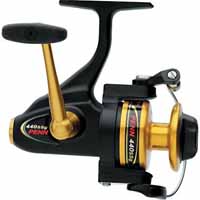  The
debate over the best rod and reel
combination for largemouth bass fishing
will likely never end, and for good
reason. The largemouth bass can be found
in every state of the union except
Alaska and is the most actively pursued
gamefish in North America. Professional
Tournament Bass Fishermen will tell you
there is no perfect rod for bass
fishing, that in order to maximize your
chances of success you have to have
multiple rods and that's what they carry
on their boats. One rod for each type of
lure they will use that is specially
designed for that class of lure, or a
certain water condition. And, most of
them use casting reels, which if learned
to use, can provide exceptional accuracy
and control. But, I'm assuming you are
reading this page in order to get
started bass fishing so let's keep it
simple. If you have read the backcountry
saltwater tackle section of this
website, you'll see I recommended a 7 ft
spinning rod with a reel rated for 8-12
# line. (I use 8#) This rod will also
work well in freshwater for bass, and if
you have something similar, by all means
use it. But for an outfit that is better
suited for bass fishing, I am going to
recommend a slightly shorter, but
stiffer rod rated for slightly higher
test line. (Note; You may have noticed
that I seem to be stuck on Penn
Spinfisher Reels and Shakespeare Ugly
Stik rods. That's just because I've been
using them for 30 + years and know more
about them. The recommendations are more
for comparison than anything else. There
are plenty of other fine brands out
there, such as Shimano, etc. The
debate over the best rod and reel
combination for largemouth bass fishing
will likely never end, and for good
reason. The largemouth bass can be found
in every state of the union except
Alaska and is the most actively pursued
gamefish in North America. Professional
Tournament Bass Fishermen will tell you
there is no perfect rod for bass
fishing, that in order to maximize your
chances of success you have to have
multiple rods and that's what they carry
on their boats. One rod for each type of
lure they will use that is specially
designed for that class of lure, or a
certain water condition. And, most of
them use casting reels, which if learned
to use, can provide exceptional accuracy
and control. But, I'm assuming you are
reading this page in order to get
started bass fishing so let's keep it
simple. If you have read the backcountry
saltwater tackle section of this
website, you'll see I recommended a 7 ft
spinning rod with a reel rated for 8-12
# line. (I use 8#) This rod will also
work well in freshwater for bass, and if
you have something similar, by all means
use it. But for an outfit that is better
suited for bass fishing, I am going to
recommend a slightly shorter, but
stiffer rod rated for slightly higher
test line. (Note; You may have noticed
that I seem to be stuck on Penn
Spinfisher Reels and Shakespeare Ugly
Stik rods. That's just because I've been
using them for 30 + years and know more
about them. The recommendations are more
for comparison than anything else. There
are plenty of other fine brands out
there, such as Shimano, etc.
Rod; Shakespeare Ugly Stick, 6 foot,
rated for 8-20 # line, Model SPL11060.
(Note; This is a one piece rod)
Reel; Penn Spinfisher SSG Graphite
450SSG
This reel is rated for 10 to 15 # line
and loaded with 15# mono, will hold
about 180 yards. I would use a minimum
of 12#. The reason I like heavier line
on a shorter rod for bass than I do in
backcountry saltwater seatrout and
redfish is not because bass are larger,
but the fishing emphasis will be
different. In flats fishing for seatrout
and redfish, the ability to cast for
distance, even with fairly light lures
is a distinct advantage as fish on the
flats, especially the larger seatrout
are spooky. Except for casting from
shore, bass fishing usually means
shorter, more precise casts up against
shorelines, stumps, weeds, and even into
tight cover with weedless lures. When a
bass hits you need to get him out of and
away from the cover or he will wrap your
line around every stump in the swamp. A
shorter, stiffer rod, with plenty of
backbone coupled with a heavier line
will give you a distinct advantage. You
can go with a lighter action rod as
mentioned above, but you will have to be
more selective in your casts, and may
miss opportunities for the biggest bass
of the day. This is explained to a
greater detail in "Freshwater 101".
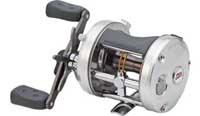  If
at some point you decide to get serious
about bass fishing, then a casting rig
may definitely be the way to go. A
quality casting rod and reel is more
challenging to use but at the same time
provide distinct advantages. Because a
casting reel's spool rotates on the cast
to let out line, the rotation must be
controlled with your thumb or else you
will end up with a massive tangle or
"birds nest" at the reel, and you'll
spend the next half hour trying to
untangle it. But, at the same time, if
you learn how to cast these, with some
of the plugs, crankbaits, spinnerbaits
and weighted worms commonly used by bass
fishers you will be able to cast with
greater precision, cast these heavier
lures further, and fish with less
fatigue as these rigs are typically
lighter that simmilar rated spinning
rigs. Plus you will have greater access
to specific actions for specific type
lures. Thats why pros use them, and in
their situation one less bass than the
competition on the tournament trail can
cost them thousands of dollars. Heres an
article on bass rods.
Choosing The Right Rod by Mark Lassagne. If
at some point you decide to get serious
about bass fishing, then a casting rig
may definitely be the way to go. A
quality casting rod and reel is more
challenging to use but at the same time
provide distinct advantages. Because a
casting reel's spool rotates on the cast
to let out line, the rotation must be
controlled with your thumb or else you
will end up with a massive tangle or
"birds nest" at the reel, and you'll
spend the next half hour trying to
untangle it. But, at the same time, if
you learn how to cast these, with some
of the plugs, crankbaits, spinnerbaits
and weighted worms commonly used by bass
fishers you will be able to cast with
greater precision, cast these heavier
lures further, and fish with less
fatigue as these rigs are typically
lighter that simmilar rated spinning
rigs. Plus you will have greater access
to specific actions for specific type
lures. Thats why pros use them, and in
their situation one less bass than the
competition on the tournament trail can
cost them thousands of dollars. Heres an
article on bass rods.
Choosing The Right Rod by Mark Lassagne.
|
|
Lures
Jump to;
Live Bait Fishing |||
Back to Top
There have probably been more lures
designed for sale to bass fishermen than
any other type of lure and with good
reason. The Largemouth Bass is likely
the most sought after fish on the
planet. With the selection below we are
going to go over a few of these and how
they are used. Some of these are going
to be old favorites of mine that have
worked for me over the years, others are
newer but proven. Again there are
thousands of lures made for bass fishing
under many different conditions. The
selection below is a very small
selection designed to give a visitor to
the area or someone just taking up bass
fishing a decent chance of bringing in
some fish.
|
|
Top Water Plugs
|
 Arbogast
Hula Popper; This is an "ancient
classic" as it has been catching fish
for over 60 years and has been a
personal favorite of mine since I began
bass fishing back in the early 1970s.
Cast it near lily pads or around other
cover or shoreline. Let it settle until
the rings in the water have almost
subsided, and then twitch. Continue to
work slowly. Comes in several sizes and
color patterns. I prefer the 2 inch 3/8
ounce size in "Frog" Arbogast
Hula Popper; This is an "ancient
classic" as it has been catching fish
for over 60 years and has been a
personal favorite of mine since I began
bass fishing back in the early 1970s.
Cast it near lily pads or around other
cover or shoreline. Let it settle until
the rings in the water have almost
subsided, and then twitch. Continue to
work slowly. Comes in several sizes and
color patterns. I prefer the 2 inch 3/8
ounce size in "Frog" |
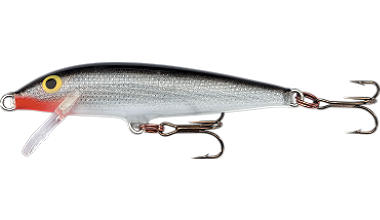 Rapala
Original Floating Minnow; Model F09;
If I were told that I had to fish with
one and only one surface plug for the
rest of my life, I would choose Rapala's
original floating minnow. First hand
carved in the 1930s out of balsa wood by
a Finnish Commercial Fisherman named
Lauri Rapala it launched an industry. It
is a very simple lure to use. Cast it,
let it settle on the surface, and then
twitch it so that it dives just beneath
the surface, let it resurface, and
repeat. If you are not catching anything
after a bit and you have enough
clearance between the surface of the
water and the bottom, about two to three
feet, just cast and reel with a steady
retrieve. This has worked for me more
than once. They come in a variety of
sizes and colors. I carry two with me,
both of them 3 1/2 inches long, one in
silver, and one in gold, and I recommend
both of them. Rapala
Original Floating Minnow; Model F09;
If I were told that I had to fish with
one and only one surface plug for the
rest of my life, I would choose Rapala's
original floating minnow. First hand
carved in the 1930s out of balsa wood by
a Finnish Commercial Fisherman named
Lauri Rapala it launched an industry. It
is a very simple lure to use. Cast it,
let it settle on the surface, and then
twitch it so that it dives just beneath
the surface, let it resurface, and
repeat. If you are not catching anything
after a bit and you have enough
clearance between the surface of the
water and the bottom, about two to three
feet, just cast and reel with a steady
retrieve. This has worked for me more
than once. They come in a variety of
sizes and colors. I carry two with me,
both of them 3 1/2 inches long, one in
silver, and one in gold, and I recommend
both of them. |
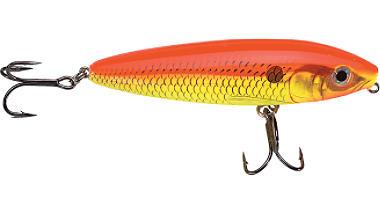 Rapala
Freshwater Skitterwalk; This version
of the Rapala Skitterwalk, as the name
implies is designed for freshwater
gamefish. Use a pulsating "Walk the Dog
action, then let it sit for a few
seconds. Repeat. This version is 3-1/8
inches and 7/16 of an ounce. Start out
with the Holographic Shad color. Rapala
Freshwater Skitterwalk; This version
of the Rapala Skitterwalk, as the name
implies is designed for freshwater
gamefish. Use a pulsating "Walk the Dog
action, then let it sit for a few
seconds. Repeat. This version is 3-1/8
inches and 7/16 of an ounce. Start out
with the Holographic Shad color. |
|
Midwater
|
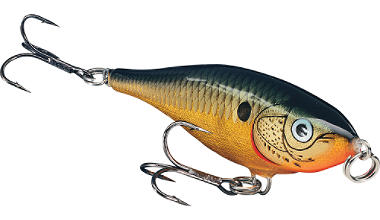 Rapala
Twitchin Rap; This lure is designed
to be nearly neutrally buoyant. Sinks
slowly in freshwater, neutrally buoyant
in saltwater. Fish it just as the name
implies. Cast, twitch slowly, let sit
for a few seconds, twtch, etc. Designed
to imitate a baitfish about to die,
signalling an easy meal for gamefish.
Runs 6" to 2' deep. Rapala
Twitchin Rap; This lure is designed
to be nearly neutrally buoyant. Sinks
slowly in freshwater, neutrally buoyant
in saltwater. Fish it just as the name
implies. Cast, twitch slowly, let sit
for a few seconds, twtch, etc. Designed
to imitate a baitfish about to die,
signalling an easy meal for gamefish.
Runs 6" to 2' deep. |
 Rapala
Shallow Shad Rap; Use this plug when
the bass are feeding on threadfin shad
or shiners. Use it as a shallow running
crankbait or a twitchbait. Shad color is
shown and is a good choice in the 2-3/4
inch, 1/4 ounce model. Runs 1' to 8'
deep. Rapala
Shallow Shad Rap; Use this plug when
the bass are feeding on threadfin shad
or shiners. Use it as a shallow running
crankbait or a twitchbait. Shad color is
shown and is a good choice in the 2-3/4
inch, 1/4 ounce model. Runs 1' to 8'
deep. |
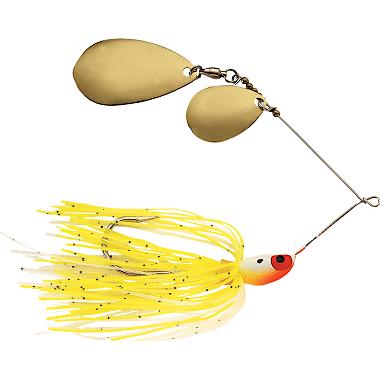 Spinnerbaits;
There are a huge variety of
spinnerbaits on the market and they
can be fished in a variety of ways,
steadily retrieved, a pulsating
retrieve wher they rise and fall (
the strike will usually come on the
fall) jigged straight up and down
over deeper structure. They can also
be buzzed along the surface through
patches of lily pads although there
is a similar type lure designed just
for this (below). Spinnerbaits;
There are a huge variety of
spinnerbaits on the market and they
can be fished in a variety of ways,
steadily retrieved, a pulsating
retrieve wher they rise and fall (
the strike will usually come on the
fall) jigged straight up and down
over deeper structure. They can also
be buzzed along the surface through
patches of lily pads although there
is a similar type lure designed just
for this (below).
|
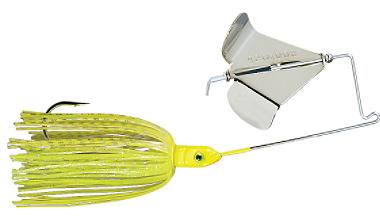 BuzzBaits;
Above under spinnerbaits I mentioned
buzzing the surface. this is where the
retrieve is fast enough and the rod tip
is held high enough to where the blades
are breaking the surface, during the
retrieve. This is to simulate the sound
of a small school of shad or other prey
skipping across the surface. Work around
and through lily pads and other emergent
or floating vegetation. BuzzBaits;
Above under spinnerbaits I mentioned
buzzing the surface. this is where the
retrieve is fast enough and the rod tip
is held high enough to where the blades
are breaking the surface, during the
retrieve. This is to simulate the sound
of a small school of shad or other prey
skipping across the surface. Work around
and through lily pads and other emergent
or floating vegetation. |
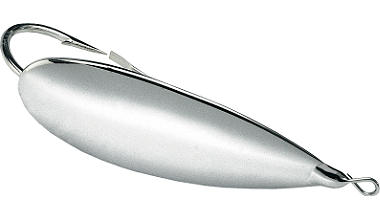 Johnson's
Silver Minnow; The spoon is one of
the oldest lures in use and still one of
the best. The Johnson's Silver Minnow is
a classic and should be in every
tacklebox. Rigged weedless, this spoon
can be fished through some very tight
cover and thick vegetation. They can be
dressed with a strip of porkrind for
added action. Cast and retrieve it with
a pulsating action, jig over deeper
structure, or even skipped over thick
lily pads. Attach to line with a snap
swivel to avoid twisting your line. Johnson's
Silver Minnow; The spoon is one of
the oldest lures in use and still one of
the best. The Johnson's Silver Minnow is
a classic and should be in every
tacklebox. Rigged weedless, this spoon
can be fished through some very tight
cover and thick vegetation. They can be
dressed with a strip of porkrind for
added action. Cast and retrieve it with
a pulsating action, jig over deeper
structure, or even skipped over thick
lily pads. Attach to line with a snap
swivel to avoid twisting your line. |
|
Soft Baits
|
 Worm
Hook; For soft plastic baits this is
the type hook you will be using. It is
designed to be inserted into the front
of a soft bait, exited just behind the
head of the bait the same length as the
shrt shaft coming from the eye, then
reinserted into the bait in order to
provide for a completely weedless
presentation. Worm
Hook; For soft plastic baits this is
the type hook you will be using. It is
designed to be inserted into the front
of a soft bait, exited just behind the
head of the bait the same length as the
shrt shaft coming from the eye, then
reinserted into the bait in order to
provide for a completely weedless
presentation. |
 Here
is a basic diagram of how a worm hook
should be inserted into the head of a
plastic worm. This also works with lures
such as the bass assassin farther down
on this page. However, for using fish
shaped or other creature shaped soft
lures, insert so that the exposed curve
of the hook protrudes from the bottom of
the lure's "chin" and is reinserted into
the "belly". In this way the most weight
of the hook will cause the lure to ride
upright. Here
is a basic diagram of how a worm hook
should be inserted into the head of a
plastic worm. This also works with lures
such as the bass assassin farther down
on this page. However, for using fish
shaped or other creature shaped soft
lures, insert so that the exposed curve
of the hook protrudes from the bottom of
the lure's "chin" and is reinserted into
the "belly". In this way the most weight
of the hook will cause the lure to ride
upright. |
 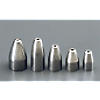 Plastic
Worms; This is one of the all time
favorite bass lures and its use has lead
to revolutions in fishing rod designs as
in the 1970s, Worm Rods, the first
classification of rods specifically
designed for bass fishing with specific
lures were introduced. Short and stout,
they were designed to allow casting of
worms rigged weedless into heavy cover
and pull bass out. These can be fished
with without extra weight or with bullet
weights (inset) to allow for greater
casting distance, especially with the
baitcasting worm rods favored by so many
advanced and professional bass fishers.
I like fishing these by throwing them
weightless on top of lily pads matted
vegetation such as duckweed or even up
on a shoreline and then "crawling" them
into the water. I've also dragged them
over matted vegetaion and had bass take
them on the surface Plastic
Worms; This is one of the all time
favorite bass lures and its use has lead
to revolutions in fishing rod designs as
in the 1970s, Worm Rods, the first
classification of rods specifically
designed for bass fishing with specific
lures were introduced. Short and stout,
they were designed to allow casting of
worms rigged weedless into heavy cover
and pull bass out. These can be fished
with without extra weight or with bullet
weights (inset) to allow for greater
casting distance, especially with the
baitcasting worm rods favored by so many
advanced and professional bass fishers.
I like fishing these by throwing them
weightless on top of lily pads matted
vegetation such as duckweed or even up
on a shoreline and then "crawling" them
into the water. I've also dragged them
over matted vegetaion and had bass take
them on the surface |
 Bass
Assassin Shad Assassin; Rigged
weedless using a size 2/O worm hook
(above), and cast with no extra weight,
this lure can be cast among lily pads,
near stumps and other cover and then
twitched slowly. It will act like a
disorientated or dying minnow and can be
hard for bass to resist. Bass
Assassin Shad Assassin; Rigged
weedless using a size 2/O worm hook
(above), and cast with no extra weight,
this lure can be cast among lily pads,
near stumps and other cover and then
twitched slowly. It will act like a
disorientated or dying minnow and can be
hard for bass to resist. |
Live Bait Fishing for Bass
Jump to;
Lures |||
Back to Top
Over the years I have caught most of
my largemouth bass on lures, but the
two largest bass I have ever caught
came on live bait. The largest, a
ten pounder was caught at a
Titusville retention pond on a small
bluegill, and the other, a 7-1/2
pounder, at the dock at Fox Lake
Park in Titusville, with a wild
caught shiner about 7 inches long.
In both cases the bait was caught at
the fishing site on an ultralite
spinning rig with a tiny hook baited
with breadballs. However, live
shiners are available at many
baitshops as well as live
nightcrawlers, which I have used as
well.
|
Fishing Live Shiners; There are many
ways of hooking a shiner for bass
fishing. What little shiner fishing I've
done for bass has been simply tying a
hook to my line and positioning a float
above the hook far enough to keep the
shiner from diving into submerged
vegetation. Use a float just large
enough to keep some control over the
shiner and see where the bait is. If it
can only pull the float under for as
second or so, that's good enough. For a
small shiner of about 2-5 inches, use a
2/O size circle hook, for a larger
shiner, use a 4/O circle hook. I've
always hooked mine through the back
slightly behind the dorsal fin, being
careful to avoid the spine. You can also
drive the hook upward through the bottom
lip and out through one of the airholes
or "nostrils" on the head. Cast this
along the edges of matted floating
weeds, near lily pads, over submerged
vegetation or other cover. When the bass
hits, the bobber will no linger be
bobbing around or going under for short
times. It will go under and stay or take
off sideways with enough force it will
travel under the water. If you're
fishing with a large shiner give the
bass several seconds to position the
fish for swallowing. Then, if using
circle hooks, do not "set" the hook with
a sharp pull. Point the rod at the fish
and begin to reel. When you feel the
force of the fish firmly hooked then
raise the rod to fight him. Here's some
links with extra information on Bass
Fishing with Shiners;
http://cyberangler.com/articles/live_bait_bass.html
http://www.bassnedge.com/tips/catching_bass_with_wild_shiners.htm
http://www.fishing.us/node/972
|
 Fishing
with Nightcrawlers; Many folks when
fishing with worms or nightcrawlers will
tend to bunch the worm or nightcrawler
by hooking it in several places along
the length. If using nightcrawlers, and
targeting bass this is not necessary. I
have had many opportunities to watch a
bass in clear water attack a plastic
worm. They will approach and just before
their nose touches the bait, they will
quickly open their mouths, sucking in
water and expelling it through the
gills, with the result being that the
entire worm is instantly sucked into
their mouths. There is no nibbling here,
whoosh, and it's gone. When I fish a
nightcrawler, I simply use a baitholder
hook such as the Eagle Claw model 186 in
size 1 or 2. If you look closely at the
image above left, you will see that the
shaft of this hook has two little barbs
on the shaft. These are designed to keep
bait such as a nightcrawler from sliding
down the hook. Simply stick the point of
the hook into the front end of a
nightcrawler and work out the side so
that the hook is buried up to the eye of
the hook and the point protrudes out the
side. Fish under a bobber near cover or
just cast (freeline, no bobber or
weight) and let settle near some cover.
For a little more casting distance
without whipping the worm off the hook
and into the next county you can add a
slit shot above the hook about 12
inches. Fishing
with Nightcrawlers; Many folks when
fishing with worms or nightcrawlers will
tend to bunch the worm or nightcrawler
by hooking it in several places along
the length. If using nightcrawlers, and
targeting bass this is not necessary. I
have had many opportunities to watch a
bass in clear water attack a plastic
worm. They will approach and just before
their nose touches the bait, they will
quickly open their mouths, sucking in
water and expelling it through the
gills, with the result being that the
entire worm is instantly sucked into
their mouths. There is no nibbling here,
whoosh, and it's gone. When I fish a
nightcrawler, I simply use a baitholder
hook such as the Eagle Claw model 186 in
size 1 or 2. If you look closely at the
image above left, you will see that the
shaft of this hook has two little barbs
on the shaft. These are designed to keep
bait such as a nightcrawler from sliding
down the hook. Simply stick the point of
the hook into the front end of a
nightcrawler and work out the side so
that the hook is buried up to the eye of
the hook and the point protrudes out the
side. Fish under a bobber near cover or
just cast (freeline, no bobber or
weight) and let settle near some cover.
For a little more casting distance
without whipping the worm off the hook
and into the next county you can add a
slit shot above the hook about 12
inches. |
Other Baits for Bass; Bass will eat
just about any animal that will fit in
its mouth, including crickets and
grasshoppers on one end of the spectrum
to frogs, salamanders, mice, baby ducks,
and even newly hatched alligators. I
dont reccommend using mice, ducks, or
alligators but frogs and waterdogs make
great bass baits. A waterdog is the
aquatic larva stage of a tiger
salamander. Hook these upward through
the lips, being sure to size the hook to
the bait and freeline the baits around
cover. Here's a couple of articles on
that.
http://www.hiddenfishingtips.com/guide/bass-live-bait.html
http://www.associatedcontent.com/article/1725354 |
|
|
|
|